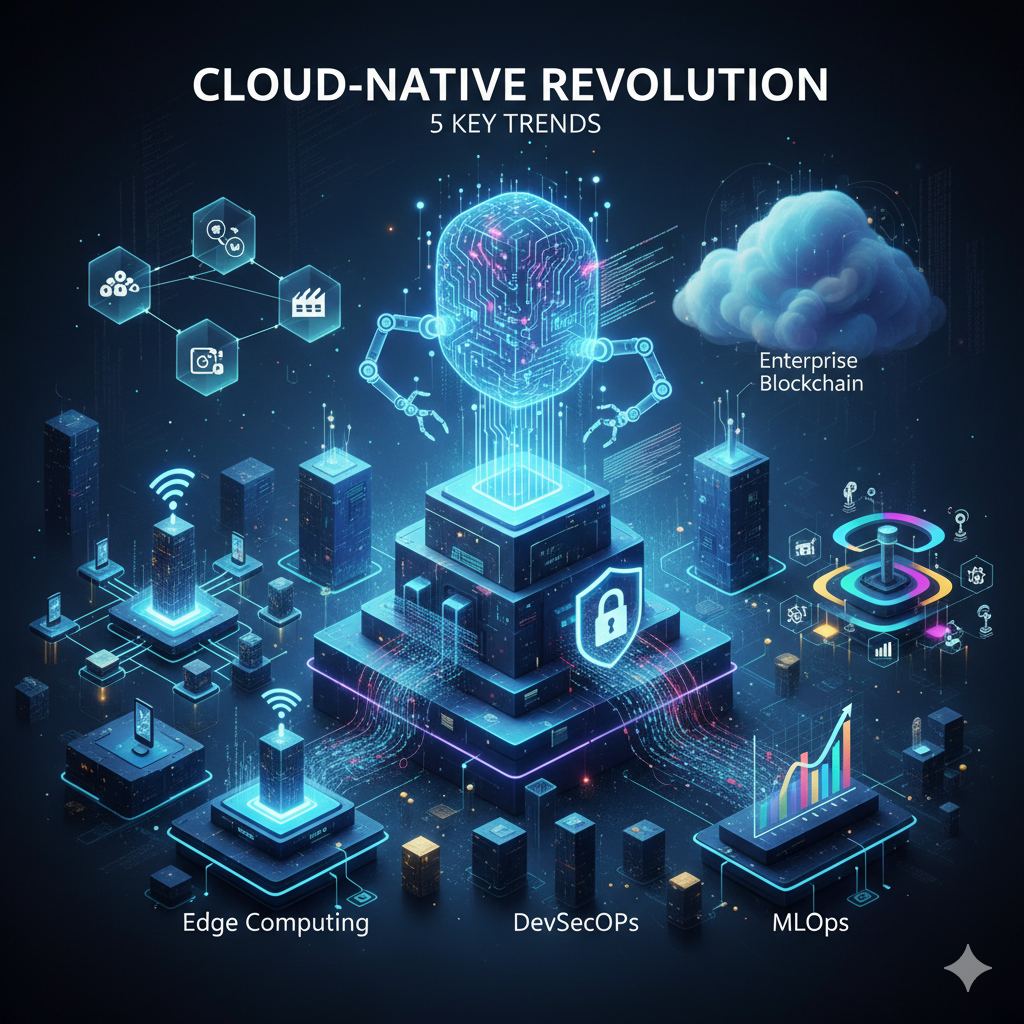1. Introduction: The New Era of Software
-
Hook: Begin by highlighting the shift from traditional, monolithic applications to modern, flexible, and scalable cloud-native architectures. Use an analogy to make it relatable (e.g., "From a single, rigid skyscraper to a network of interconnected, easily upgradeable pods").
-
State the Problem: Explain the limitations of old systems: slow deployment cycles, difficulty in scaling, and a lack of resilience.
-
Introduce the Solution: Define cloud-native as an approach to building and running applications that take full advantage of the cloud computing model. Mention its core benefits: agility, resilience, and scalability.
-
Preview the Content: Briefly list the 5 key trends you will discuss to entice the reader to continue.
2. Trend 1: AI-Augmented Development and Generative AI
-
Concept: Explain how AI is no longer just for end-user applications; it's now a tool for developers. Generative AI tools are becoming central to the software development lifecycle (SDLC).
-
Data and Examples:
-
Market Data: Mention that tools like GitHub Copilot are being adopted by a significant percentage of software teams, with some studies showing they complete tasks in as little as 26% of the time it would take without AI.
-
Specific Use Cases:
-
Code Generation and Auto-completion: AI can suggest entire blocks of code.
-
Automated Refactoring: AI helps improve code quality and structure.
-
Automated Testing and Debugging: AI can write tests and identify bugs, saving developer time.
-
-
-
Future Outlook: Discuss the rise of "agentic AI" and "vibe coding," where AI autonomously handles complex tasks and developers write software using natural language instructions. This will make non-technical stakeholders "citizen developers."
3. Trend 2: The Dominance of DevSecOps
Concept: Frame cybersecurity not as a final step, but as an integral part of the development process. DevSecOps ("Development + Security + Operations") is the new standard.
-
Data and Examples:
-
Why it's Crucial: Mention the increasing sophistication of cyberattacks, including nation-state actors and supply chain vulnerabilities.
-
Core Principles: Explain key practices that are now standard:
-
"Shifting Left": Integrating security from the very beginning of the SDLC.
-
Continuous Security Testing: Automated security scans within the CI/CD pipeline.
-
Zero Trust Architecture: The principle of "never trust, always verify" for all users and devices, regardless of their location.
-
-
-
Your Company's Angle: This is a great place to subtly mention how your company's software or services help clients implement robust DevSecOps practices.
4. Trend 3: The Maturing of Edge Computing and Distributed Architectures
-
Concept: Explain the need for low-latency, real-time processing as more devices (IoT, mobile, etc.) generate data. Edge computing pushes computation closer to the data source.
-
Data and Examples:
-
IoT and 5G: Discuss how the proliferation of IoT devices and the rollout of 5G networks are making edge computing a necessity for applications in manufacturing, healthcare, and smart cities.
-
Architectural Models: Detail the continued evolution of microservices, serverless, and event-driven architectures. Explain how these distributed systems enable scalability and resilience.
-
Cloud Native Components: Reiterate the role of containers (Docker) and container orchestration platforms (Kubernetes) in managing these complex, distributed systems.
-
5. Trend 4: The Strategic Rise of Machine Learning Operations (MLOps)
-
Concept: Explain that getting a machine learning model to work is one thing; deploying and managing it at scale in a production environment is another. MLOps, like DevOps, is a practice that bridges the gap between data science and IT operations.
-
Data and Examples:
-
Market Growth: Use data to highlight the importance of ML. The global machine learning market, valued at $35.32 billion in 2024, is projected to reach over $309 billion by 2032, with a CAGR of 30.5%.
-
Challenges MLOps Solves: Address the common pain points:
-
Data Drift: Ensuring models remain accurate as real-world data changes.
-
Scalability: Deploying models that can handle massive amounts of data.
-
Model Monitoring: Continuously tracking model performance to detect issues.
-
-
-
Industry Applications: Provide concrete examples of how ML is changing industries: fraud detection in finance, medical diagnoses in healthcare, and personalized recommendations in e-commerce.
6. Trend 5: Blockchain's Enterprise Renaissance
-
Concept: Move beyond cryptocurrency and explain blockchain's growing role as a foundational technology for trust, transparency, and security in enterprise applications.
-
Data and Examples:
-
Market Adoption: Mention that over 80% of top global companies are actively exploring or using blockchain solutions. The global blockchain market is predicted to reach $95.2 billion by 2025.
-
Applications:
-
Supply Chain Management: Use blockchain for enhanced traceability and transparency (e.g., tracking a product from origin to consumer).
-
Real-World Asset Tokenization: Explain how physical or financial assets (like real estate or bonds) can be converted into secure, blockchain-based tokens to improve liquidity and fractional ownership.
-
Identity Management: Use blockchain for secure, self-sovereign identity systems.
-
-
7. Conclusion: The Road Ahead
-
Summarize: Briefly recap the 5 key trends.
-
Call to Action (CTA): Gently pivot to your company's services. Explain that navigating these complex trends requires a skilled and experienced partner. Invite readers to contact your team for a consultation on how to implement these technologies for their specific business needs. This is your chance to show how your company is part of this revolution.
Explore the future of software with 5 essential cloud-native trends: AI-augmented dev, DevSecOps, Edge Computing, MLOps & Enterprise Blockchain. Stay ahead in modern software development.



